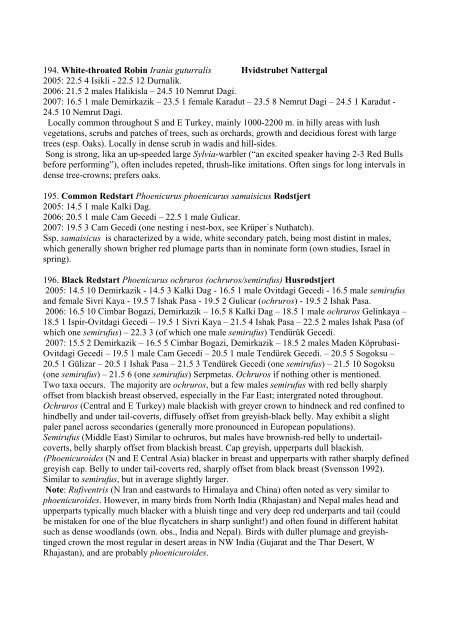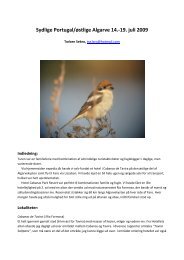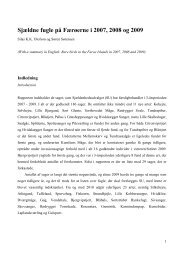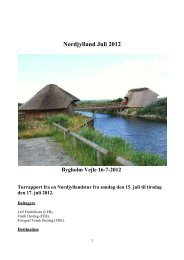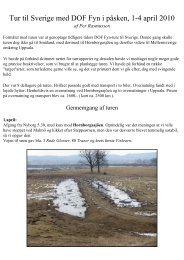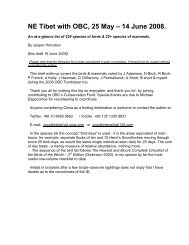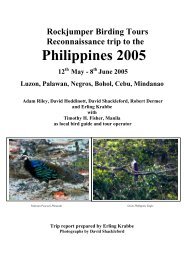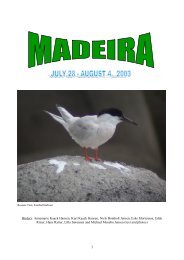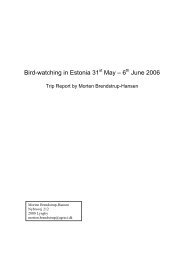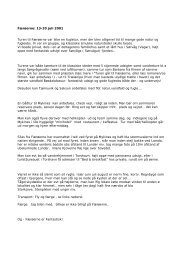TURKEY - a report from a birdwatching trip to Central ... - Netfugl.dk
TURKEY - a report from a birdwatching trip to Central ... - Netfugl.dk
TURKEY - a report from a birdwatching trip to Central ... - Netfugl.dk
Create successful ePaper yourself
Turn your PDF publications into a flip-book with our unique Google optimized e-Paper software.
194. White-throated Robin Irania guturralis Hvidstrubet Nattergal<br />
2005: 22.5 4 Isikli - 22.5 12 Durnalik.<br />
2006: 21.5 2 males Halikisla – 24.5 10 Nemrut Dagi.<br />
2007: 16.5 1 male Demirkazik – 23.5 1 female Karadut – 23.5 8 Nemrut Dagi – 24.5 1 Karadut -<br />
24.5 10 Nemrut Dagi.<br />
Locally common throughout S and E Turkey, mainly 1000-2200 m. in hilly areas with lush<br />
vegetations, scrubs and patches of trees, such as orchards, growth and decidious forest with large<br />
trees (esp. Oaks). Locally in dense scrub in wadis and hill-sides.<br />
Song is strong, lika an up-speeded large Sylvia-warbler (“an excited speaker having 2-3 Red Bulls<br />
before performing”), often includes repeted, thrush-like imitations. Often sings for long intervals in<br />
dense tree-crowns; prefers oaks.<br />
195. Common Redstart Phoenicurus phoenicurus samaisicus Rødstjert<br />
2005: 14.5 1 male Kalki Dag.<br />
2006: 20.5 1 male Cam Gecedi – 22.5 1 male Gulicar.<br />
2007: 19.5 3 Cam Gecedi (one nesting i nest-box, see Krüper´s Nuthatch).<br />
Ssp. samaisicus is characterized by a wide, white secondary patch, being most distint in males,<br />
which generally shown brigher red plumage parts than in nominate form (own studies, Israel in<br />
spring).<br />
196. Black Redstart Phoenicurus ochruros (ochruros/semirufus) Husrødstjert<br />
2005: 14.5 10 Demirkazik - 14.5 3 Kalki Dag - 16.5 1 male Ovitdagi Gecedi - 16.5 male semirufus<br />
and female Sivri Kaya - 19.5 7 Ishak Pasa - 19.5 2 Gulicar (ochruros) - 19.5 2 Ishak Pasa.<br />
2006: 16.5 10 Cimbar Bogazi, Demirkazik – 16.5 8 Kalki Dag – 18.5 1 male ochruros Gelinkaya –<br />
18.5 1 Ispir-Ovitdagi Gecedi – 19.5 1 Sivri Kaya – 21.5 4 Ishak Pasa – 22.5 2 males Ishak Pasa (of<br />
which one semirufus) – 22.3 3 (of which one male semirufus) Tendürük Gecedi.<br />
2007: 15.5 2 Demirkazik – 16.5 5 Cimbar Bogazi, Demirkazik – 18.5 2 males Maden Köprubasi-<br />
Ovitdagi Gecedi – 19.5 1 male Cam Gecedi – 20.5 1 male Tendürek Gecedi. – 20.5 5 Sogoksu –<br />
20.5 1 Gülizar – 20.5 1 Ishak Pasa – 21.5 3 Tendürek Gecedi (one semirufus) – 21.5 10 Sogoksu<br />
(one semirufus) – 21.5 6 (one semirufus) Serpmetas. Ochruros if nothing other is mentioned.<br />
Two taxa occurs. The majority are ochruros, but a few males semirufus with red belly sharply<br />
offset <strong>from</strong> blackish breast observed, especially in the Far East; intergrated noted throughout.<br />
Ochruros (<strong>Central</strong> and E Turkey) male blackish with greyer crown <strong>to</strong> hindneck and red confined <strong>to</strong><br />
hindbelly and under tail-coverts, diffusely offset <strong>from</strong> greyish-black belly. May exhibit a slight<br />
paler panel across secondaries (generally more pronounced in European populations).<br />
Semirufus (Middle East) Similar <strong>to</strong> ochruros, but males have brownish-red belly <strong>to</strong> undertailcoverts,<br />
belly sharply offset <strong>from</strong> blackish breast. Cap greyish, upperparts dull blackish.<br />
(Phoenicuroides (N and E <strong>Central</strong> Asia) blacker in breast and upperparts with rather sharply defined<br />
greyish cap. Belly <strong>to</strong> under tail-coverts red, sharply offset <strong>from</strong> black breast (Svensson 1992).<br />
Similar <strong>to</strong> semirufus, but in average slightly larger.<br />
Note: Rufiventris (N Iran and eastwards <strong>to</strong> Himalaya and China) often noted as very similar <strong>to</strong><br />
phoenicuroides. However, in many birds <strong>from</strong> North India (Rhajastan) and Nepal males head and<br />
upperparts typically much blacker with a bluish tinge and very deep red underparts and tail (could<br />
be mistaken for one of the blue flycatchers in sharp sunlight!) and often found in different habitat<br />
such as dense woodlands (own. obs., India and Nepal). Birds with duller plumage and greyishtinged<br />
crown the most regular in desert areas in NW India (Gujarat and the Thar Desert, W<br />
Rhajastan), and are probably phoenicuroides.


